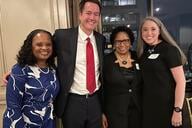You have /5 articles left.
Sign up for a free account or log in.
With a 24-hour news cycle, shrinking newsrooms and lots of competition in higher education, breaking through the noise to gain national media attention is more challenging than ever. Despite these challenges, we at Southern New Hampshire University have had great success by focusing our media outreach on our students and their stories. Over the past six years, our students have been featured in People magazine, Inside Edition, the NBC Nightly News, Live with Kelly and more. None of these stories happened by accident, and they all took careful planning, research, execution and follow-up.
Here are the top five strategies we use to harness the power of student stories, and how you can use earned media to elevate your communications, marketing and brand strategy.
- Build a story pipeline: Communicators are often not on the front line with students, so building connections internally to source the best stories is critical. Everyone has a unique story to tell, and they often are eager to share. We created a “Share your story” link that we include in student emails, on social media and with advisers and faculty members. Giving your staff, faculty, students and alumni one easy-to-remember spot to share their stories helps build the pipeline. We receive an average of 1,000 submissions per year, which has helped us yield more than 350 media placements. Even if it doesn’t yield an immediate media hit, we now have a curated and searchable list, which is useful when a reporter comes to us looking for a student with specific characteristics like “a working mom in the nursing degree programs” or “a student who is looking to change careers to the tech industry.” This helps us connect students with reporters much faster and increases our chances of being included in a story.
- Put students first: Pitch every story with an authentic, human-centered approach. Nine times out of 10, we don’t include SNHU in the first sentence or paragraph of a pitch. Instead, we lead with the student and their story. If it’s a story about a person’s academic success, it’s unlikely the reporter or outlet will run the story without mentioning the school they go to, so always put students first—it’s a win-win.
- Build and share media-ready packages: Shrinking newsrooms and a tight media market mean it is even more important for communicators to help reporters tell their stories. Before pitching a story, think about the visuals and resources you can provide. At SNHU, “diploma deliveries” are part of our brand and our story—presenting diplomas, often with an element of surprise, to students who aren’t able to celebrate their big milestone at our in-person commencement ceremonies, like 94-year-old Amy Craton and Broadway star Emily Walton. For both stories, we traveled with a photographer/videographer and captured the surprise moments. Instead of sharing a highly edited clip that took days to put together, we quickly shared one link to unedited b-roll, interview footage and still images within hours of the event so that journalists and producers could use the assets to tell the story in their own way. Two producers recently said to us, “Thank you for always making it so easy!” and “This media package was the best I’ve ever received. SNHU made it easy for us to do our job.” Be a resource. Not only will journalists be willing to share your story, but you will build a strong relationship and trust with the media for future opportunities.
- Go local to get national: Every university leader says they want to be featured in The New York Times—but you don’t need to pitch a national reporter to get national coverage. We have had the best results by harnessing the power of local affiliates to help a story gain national traction. In both of the examples noted above, broadcast affiliates in Manchester, N.H.; Honolulu; Boston; and New York City ran the pieces that were then later noticed and picked up by Live With Kelly, NBC Nightly News and many other national outlets.
- Don’t be afraid of weekends and holidays: Many of us were taught to never pitch stories on weekends, holidays or after hours, but remember—the news cycle is 24 hours, and if you have the right story at the right time, you can set yourself apart. Just this December, my team floated a potential diploma delivery to 89-year-old Joan Donovan the week before Christmas. I was hesitant. Would we be able to pull it off in time? Was it too close to the holidays? Is the team already stretched really thin? Yet the story gained traction over the course of three weeks, eventually being featured on ABC World News Tonight with David Muir. At the end of another hard year, Joan’s story of perseverance and grit resonated with people around the world, and even though we pitched the Friday afternoon before Christmas, Joan’s story yielded more than 500 media clips with a potential reach of 561 million people.
It’s an honor and a privilege to share our students’ stories, and we hope that they inspire others. Using these strategies, we extend our mission of expanding access to higher education while also creating positive associations with the university, internally and externally. At a time when Americans’ faith in the power of higher education continues to diminish, we, as higher ed communicators, have the unique opportunity and obligation to share the stories of our incredible students and how our industry is making a difference in the communities we serve.
Lauren Keane is the associate vice president of communications at Southern New Hampshire University.




